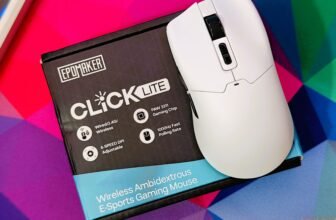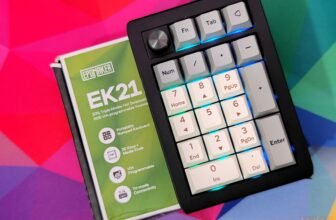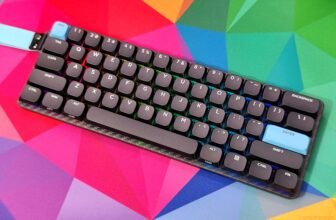The evolution of DDR5 memory has brought an impressive leap in frequency, moving from the initial 4800MHz to current speeds that surpass 7000MHz, with high-end modules reaching up to 8000MHz and beyond. Originally introduced to PCs in 2021, DDR5 memory arrived at 4800MHz, but with the ongoing advancements in motherboard and CPU technology, memory frequencies have kept pace, achieving remarkable speeds that are essential for high-performance computing.
TEAMGROUP’s T-Force, a brand known for gaming-focused components, recently launched the XTREEM ARGB DDR5 series, designed for enthusiasts and overclockers seeking peak performance. This latest addition to the T-Force lineup features a high-quality 10-layer PCB to reduce interference and boasts a maximum frequency of 8200MHz. The XTREEM ARGB series aims to meet the demands of users looking to push their systems to the limits, achieving record-breaking benchmarks and unlocking the full potential of their PCs.
Previously, we reviewed T-Force’s XTREEM DDR5-7600 memory kit, which consists of 48GB across 2x24GB modules. In this review, we turn our attention to the new T-Force XTREEM ARGB variant, a high-end memory kit also rated at DDR5-7600, and sent us a 32GB – 2x16GB Kit configuration. This high-performance memory kit promises impressive speeds while bringing RGB aesthetics and high-end reliability to any enthusiast setup.
Packaging
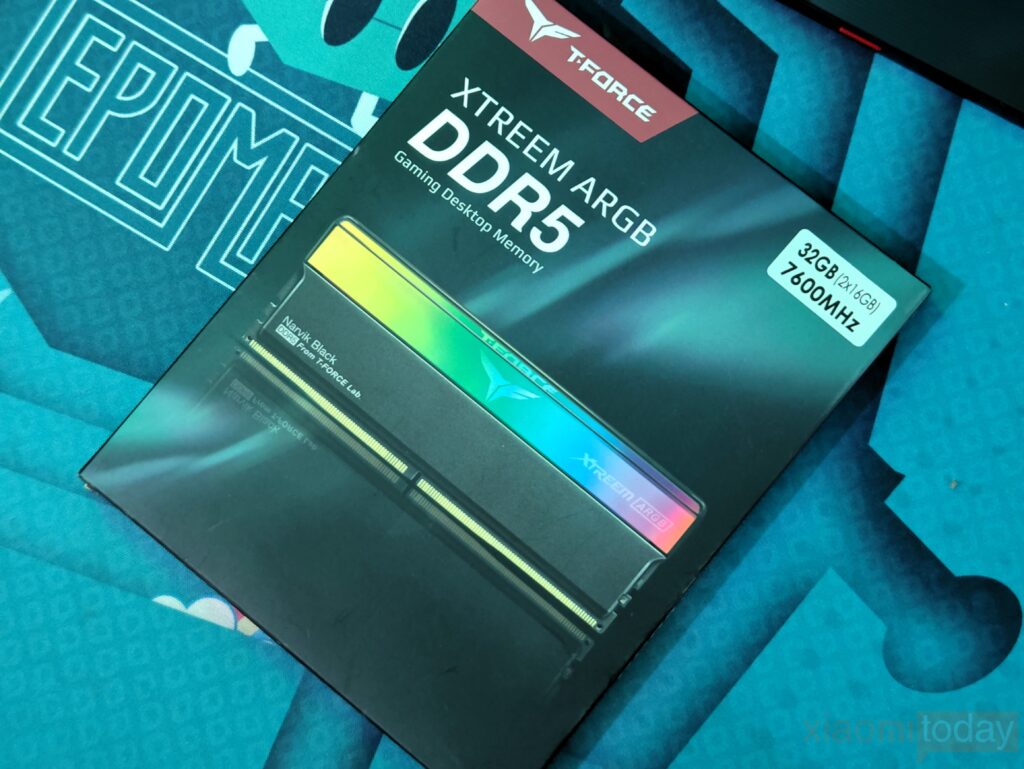

Starting with the packaging, the TEAMGROUP T-FORCE XTREEM ARGB DDR5 comes in a distinct box that sets it apart from the non-ARGB XTREEM DDR5 version. The box features a unique aurora-like background design, enhancing its visual appeal. Centered on the front is an ARGB image of the XTREEM ARGB DDR5 module, with the T-FORCE logo and model name in the upper left corner, and a memory specification sticker in the upper right. The kit under review includes two 16GB modules, totaling 32GB of memory.

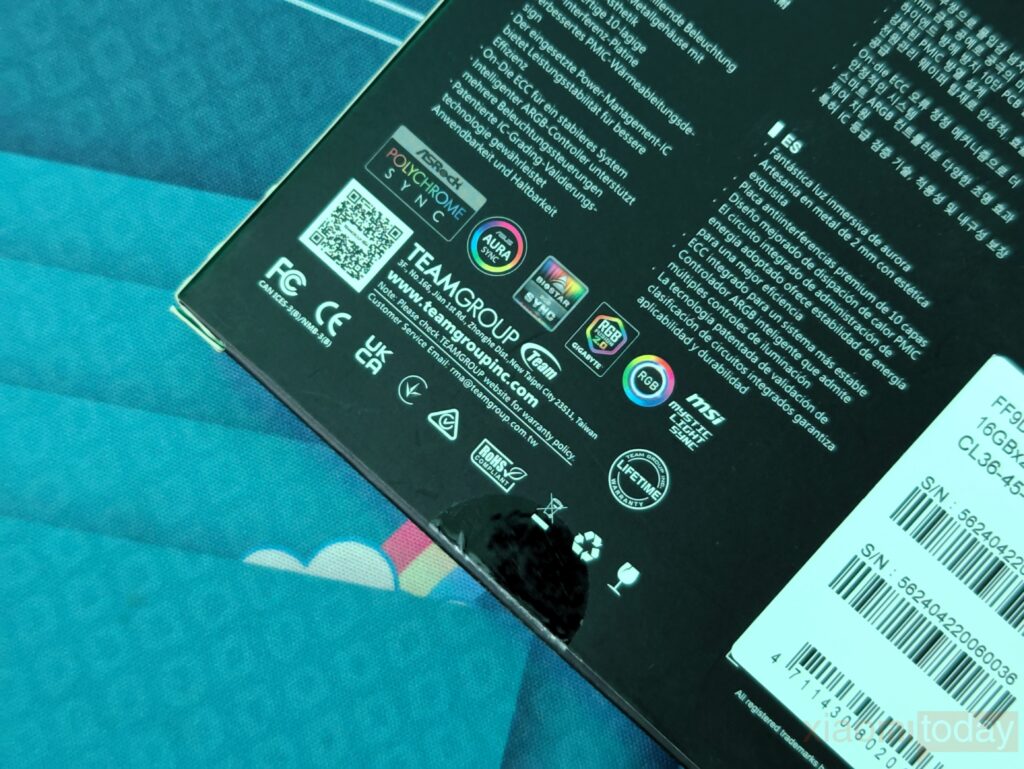

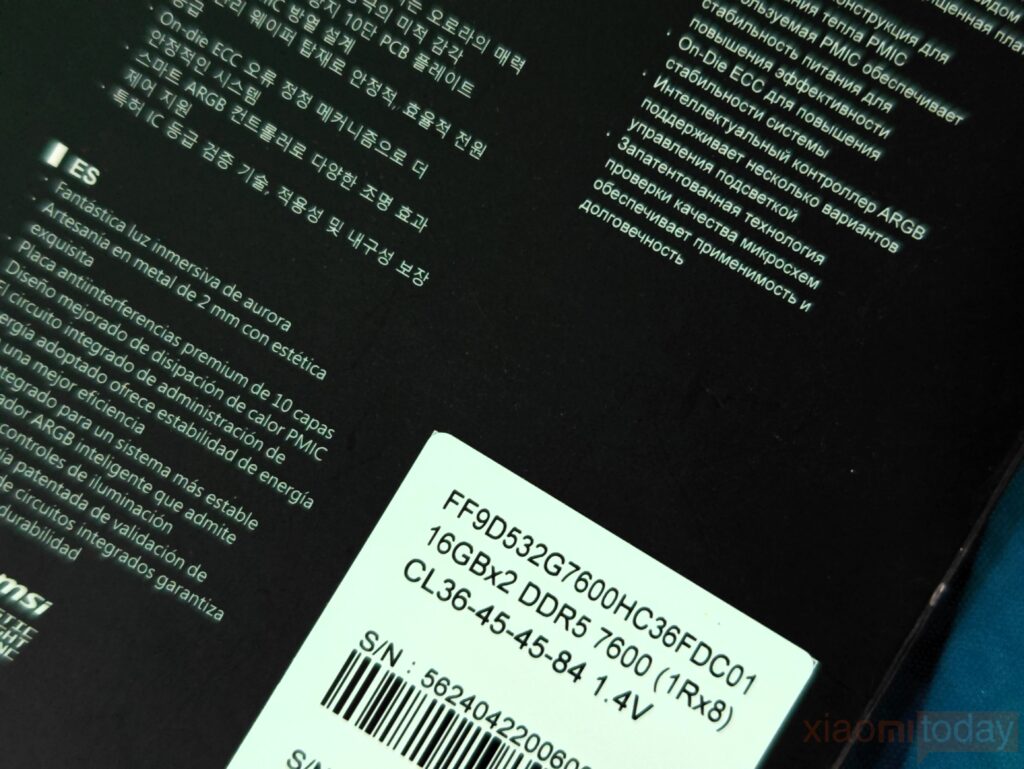
The back of the packaging displays a range of product details in several languages, including key features, product serial numbers, and compatible lighting synchronization functions. Supported lighting systems cover major brands, such as ASRock’s POLYCHROME SYNC, ASUS AURA SYNC, Biostar RGB SYNC, GIGABYTE RGB FUSION 2.0, and MSI’s MYSTIC LIGHT, ensuring compatibility with popular motherboard options available today. A lifetime warranty label is also visible in the lower right corner, indicating long-term support for the product.
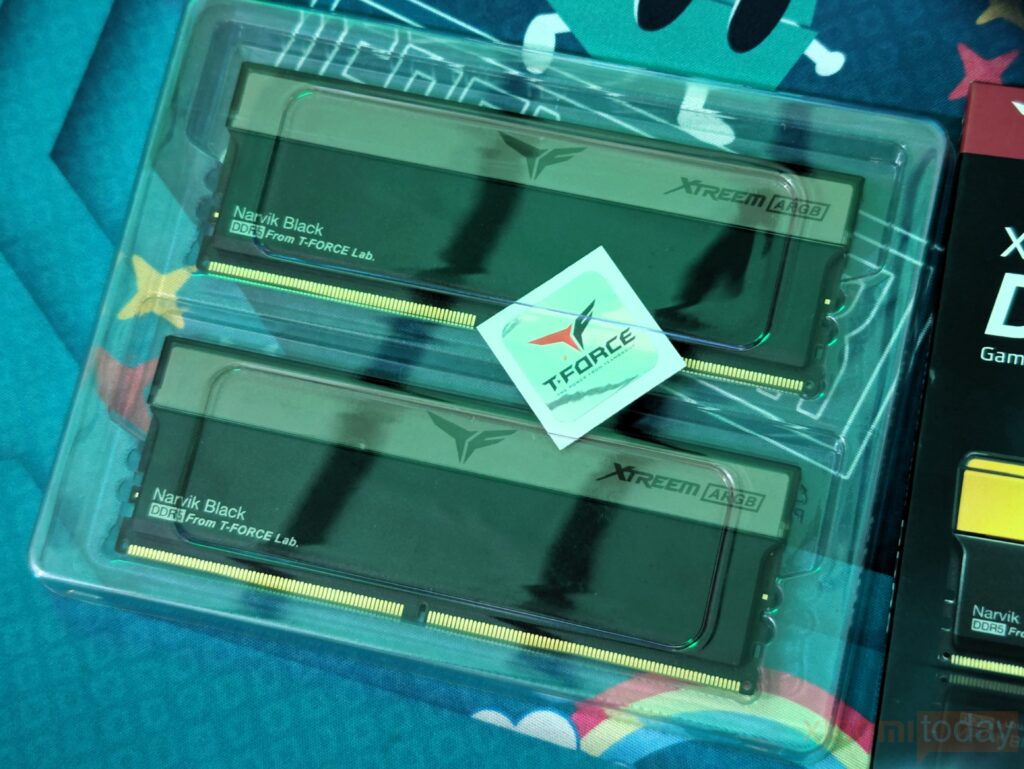
The T-FORCE XTREEM ARGB DDR5 kit arrives in a protective semi-rigid plastic blister, which shields the RAM from any potential transit damage. The package is straightforward, containing the T-FORCE XTREEM ARGB DDR5 modules and a manufacturer’s sticker, keeping the presentation minimal and functional.
Closer Look

The design of the T-Force XTREEM DDR5 memory maintains the distinctive mirror style seen in its DDR4 counterpart, though with noticeable differences. The DDR5 version moves away from the full specular reflection and light penetration used in the DDR4 model, instead opting for a light guide area at the top of the module. This change shifts the focus to the upper portion of the memory, while the lower part of the heat sink is made thicker, enhancing its ability to handle the heat generated by high-clock DDR5 operations. The overall design prioritizes both aesthetics and functionality, ensuring efficient heat dissipation.
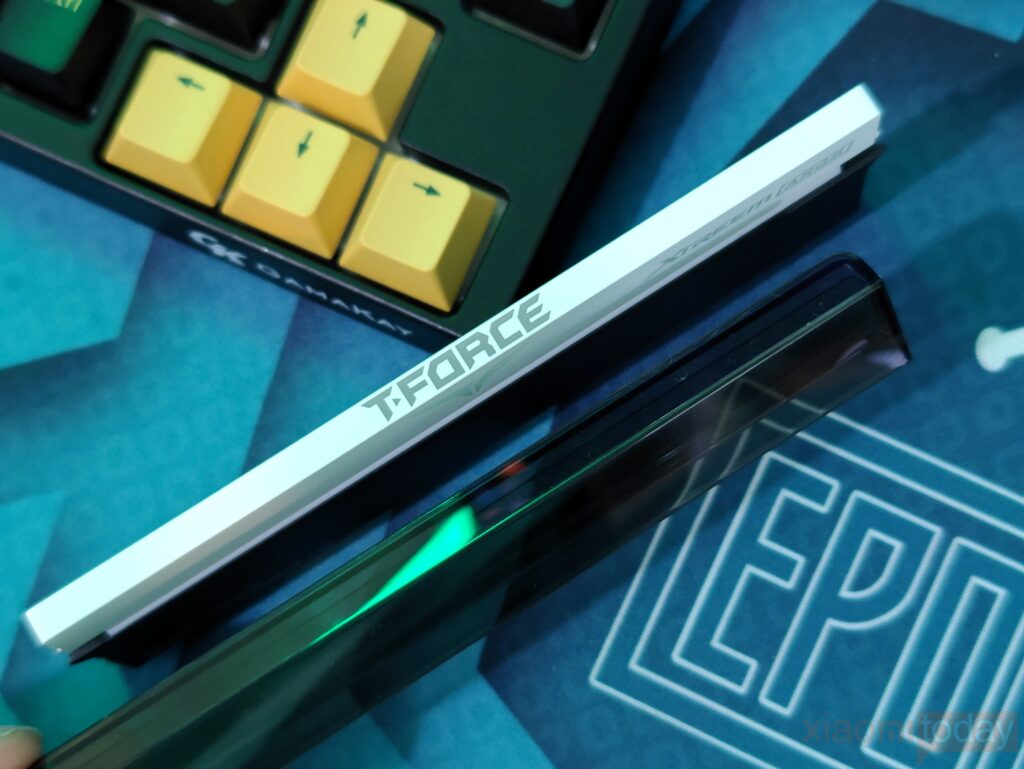
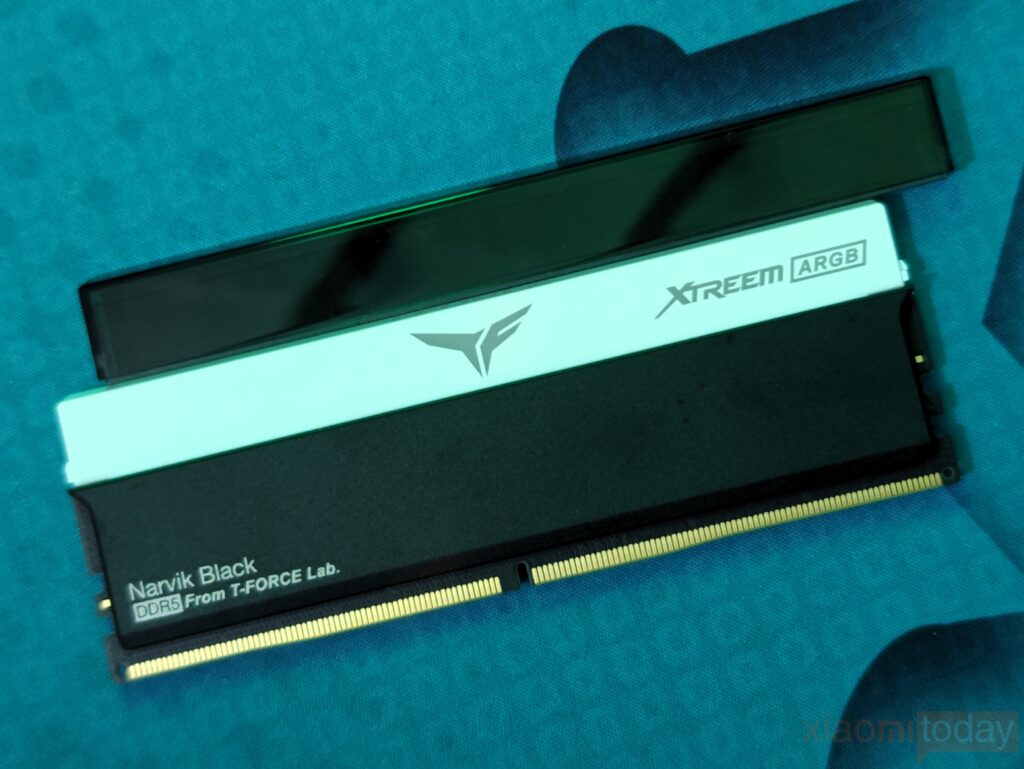
The T-FORCE XTREEM ARGB DDR5 uses a two-piece light pipe that channels light through a translucent, multilayered optical design, creating a soft, aurora-like effect. Inside, a thick white light strip is positioned to enhance the inner glow, while a brown transparent outer cover diffuses the light, resulting in a smooth and consistent flow. This layered structure produces a unique visual experience, with the lighting elements blending seamlessly to evoke a calm, immersive ambient effect.

The XTREEM ARGB DDR5 introduces a shift from its predecessor’s full mirror design, opting instead for a pair of 2mm aluminum heat sinks. Positioned at the bottom, these aluminum heat sinks are designed to manage heat more effectively under demanding loads. Manufactured using aluminum extrusion and CNC processing, and finished with a sandblasted black surface treatment, the result is a distinctive Narvik Black basalt appearance, which reveals a white or gray-speckled granite-like effect when exposed to light. T-Force Lab has specially selected DDR5 memory chips to ensure consistent quality and performance.

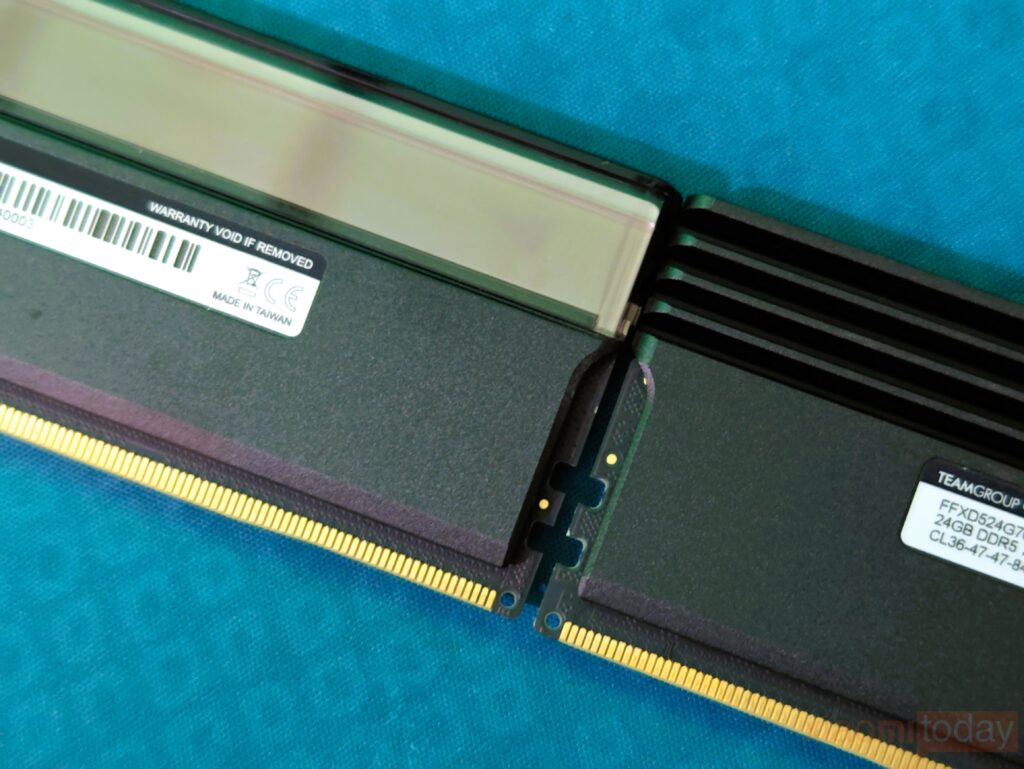
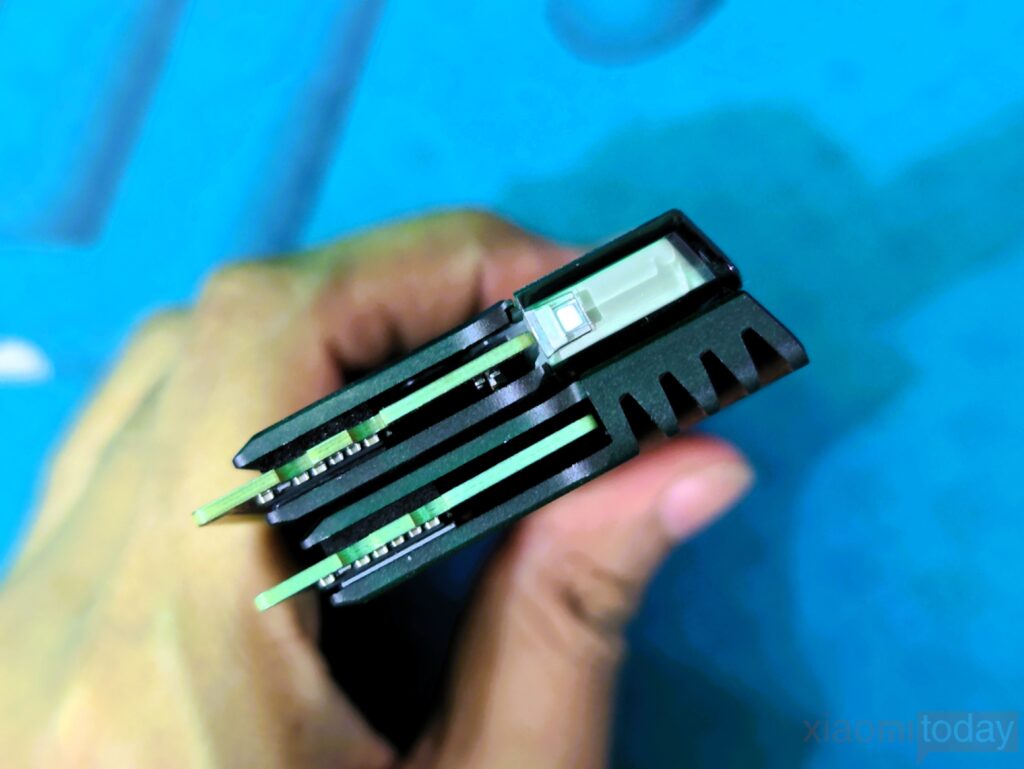
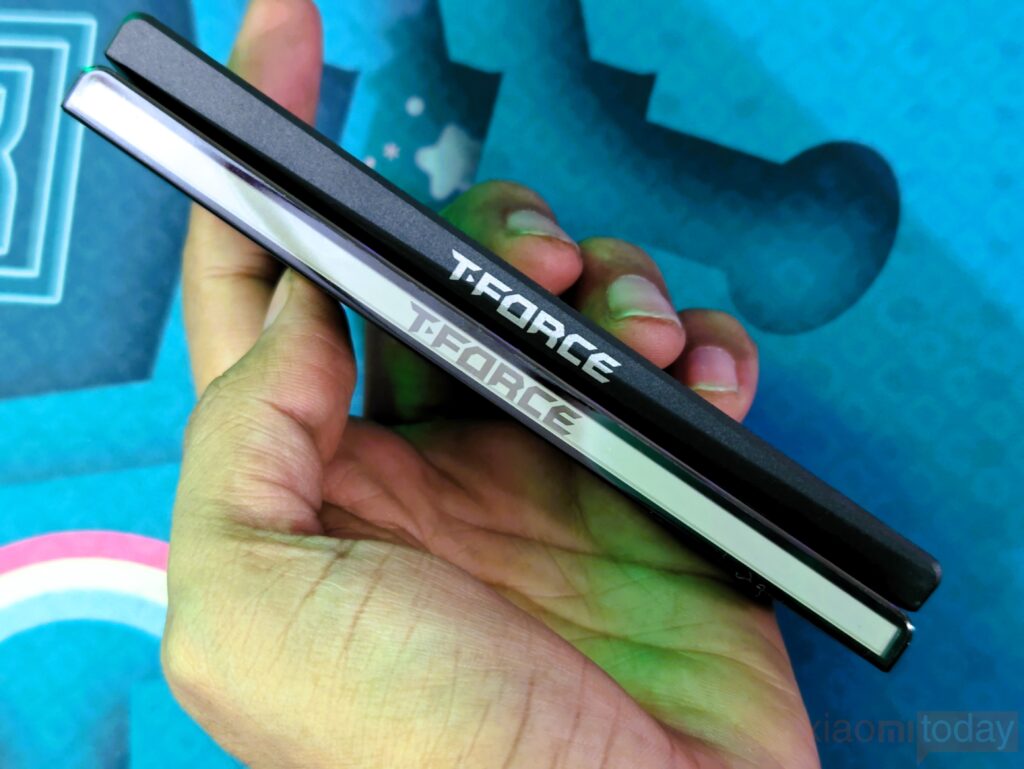
In comparison to the non-RGB model, the TEAMGROUP T-FORCE XTREEM ARGB showcases a redesigned upper section, where the light effect area is more pronounced. On the back, the RGB version has an expanded lighting zone that occupies more space than the cooling fins on the non-RGB variant. Viewed from the front and side, it retains a single-sided 1R x8 chip setup, combining an efficient layout with an aesthetic that emphasizes both cooling and lighting.

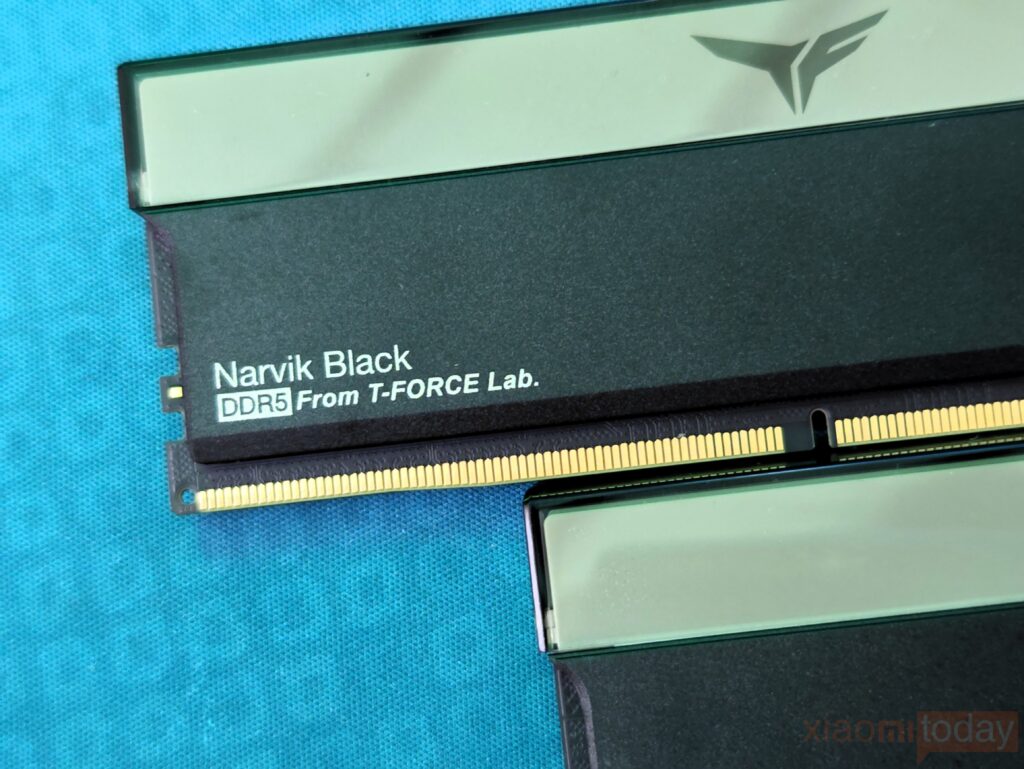

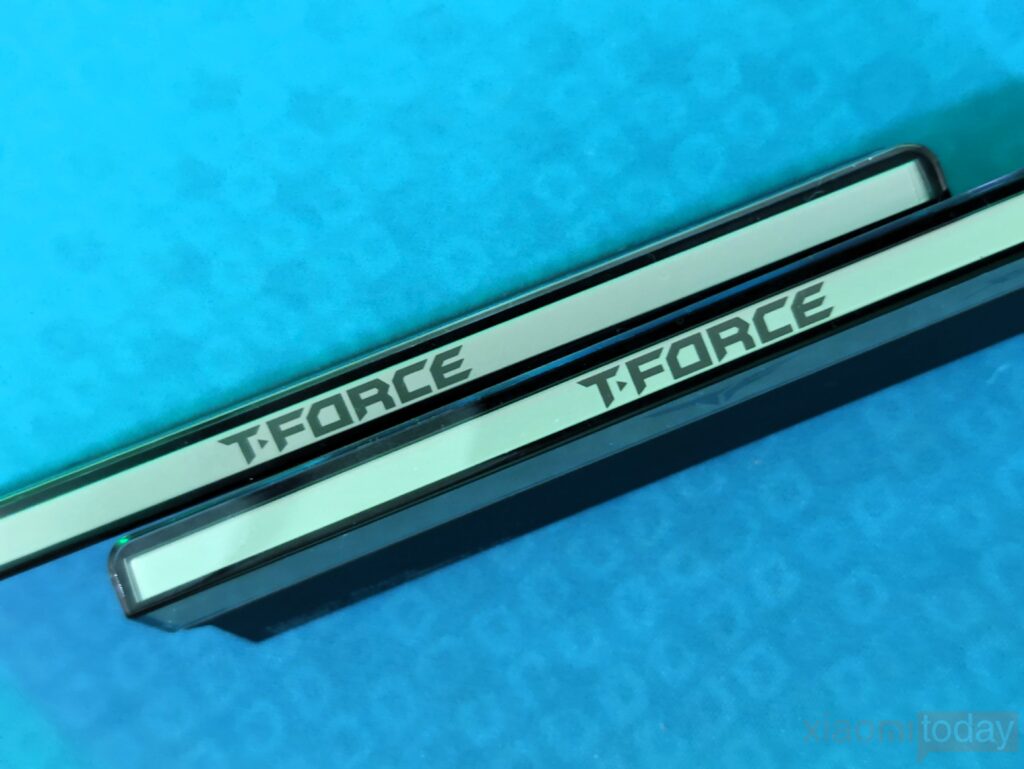
The RGB section of the module features the T-Force logo alongside the XTREEM ARGB text. The lower-left corner displays the same Narvik Black heat sink design found on the non-RGB version. On the back, you’ll find stickers detailing the product specifications and serial numbers.
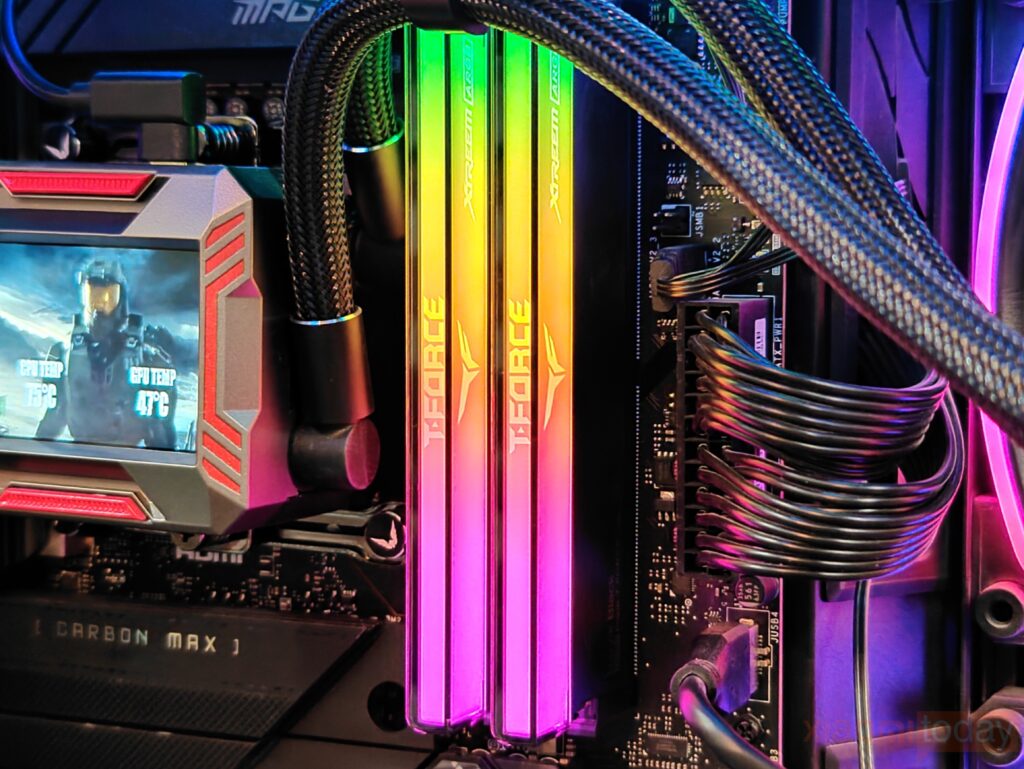
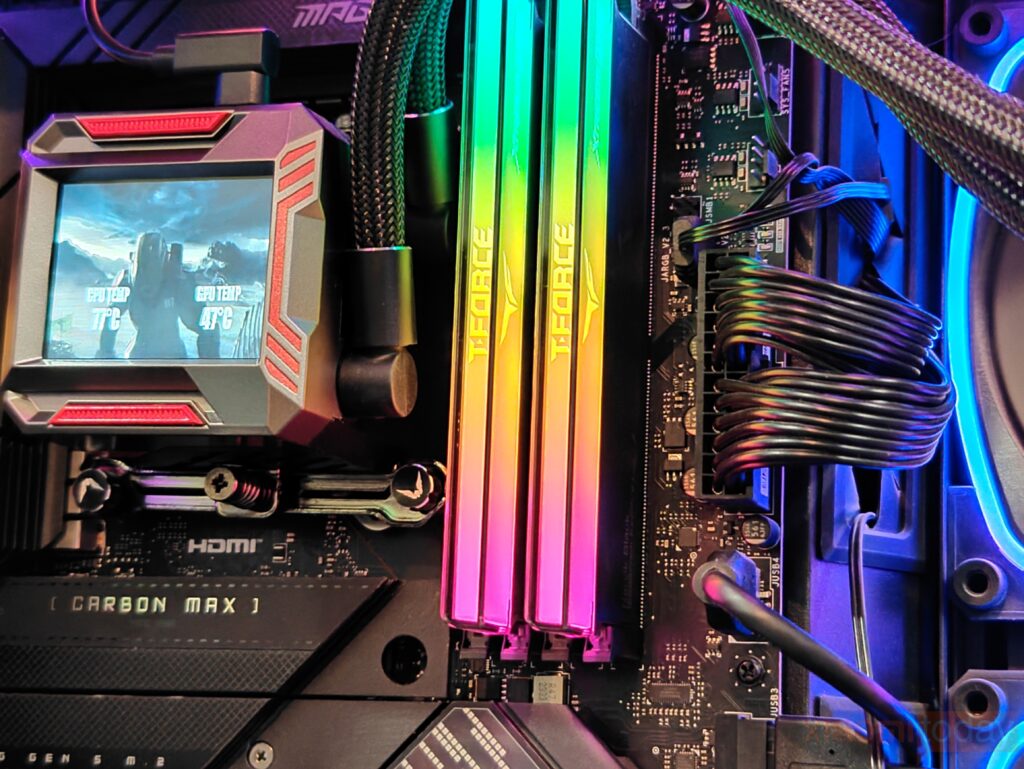
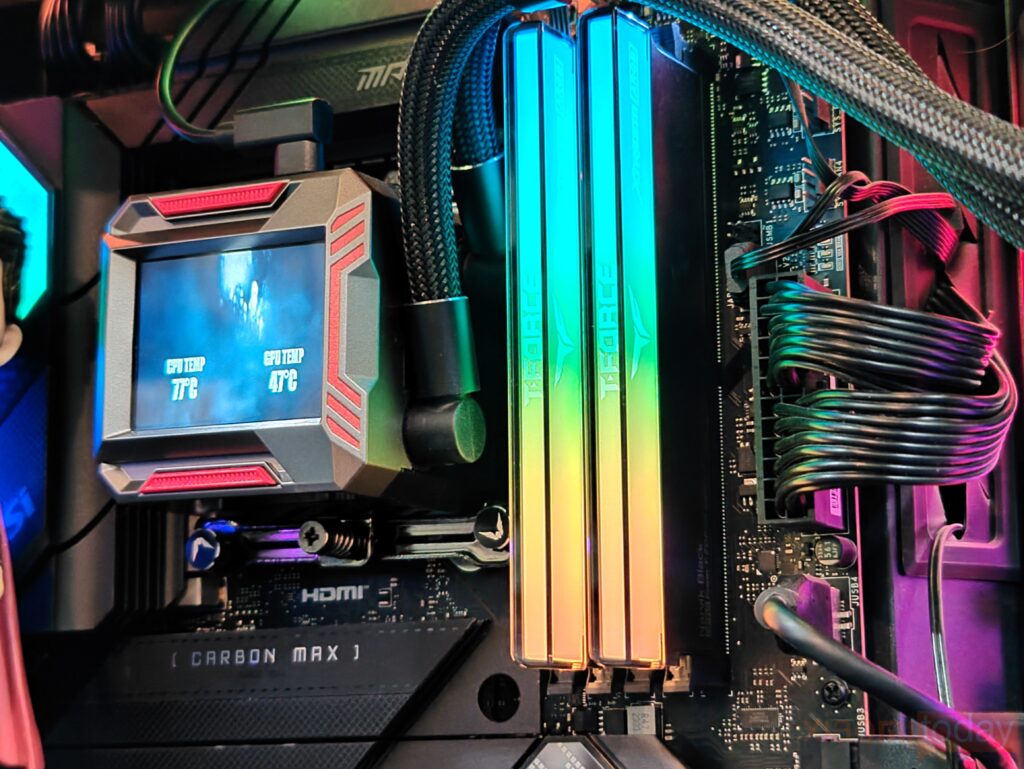
The T-Force XTREEM ARGB DDR5 memory module features an innovative design that leverages optical reflection and a light-transmitting pipe to enhance its visual appeal. Equipped with 10 high-brightness RGB LEDs, it achieves a large and striking light-emitting area. The mirror-like finish further amplifies this effect, creating a layered and reflective aesthetic across the top light bar for a visually impactful display.
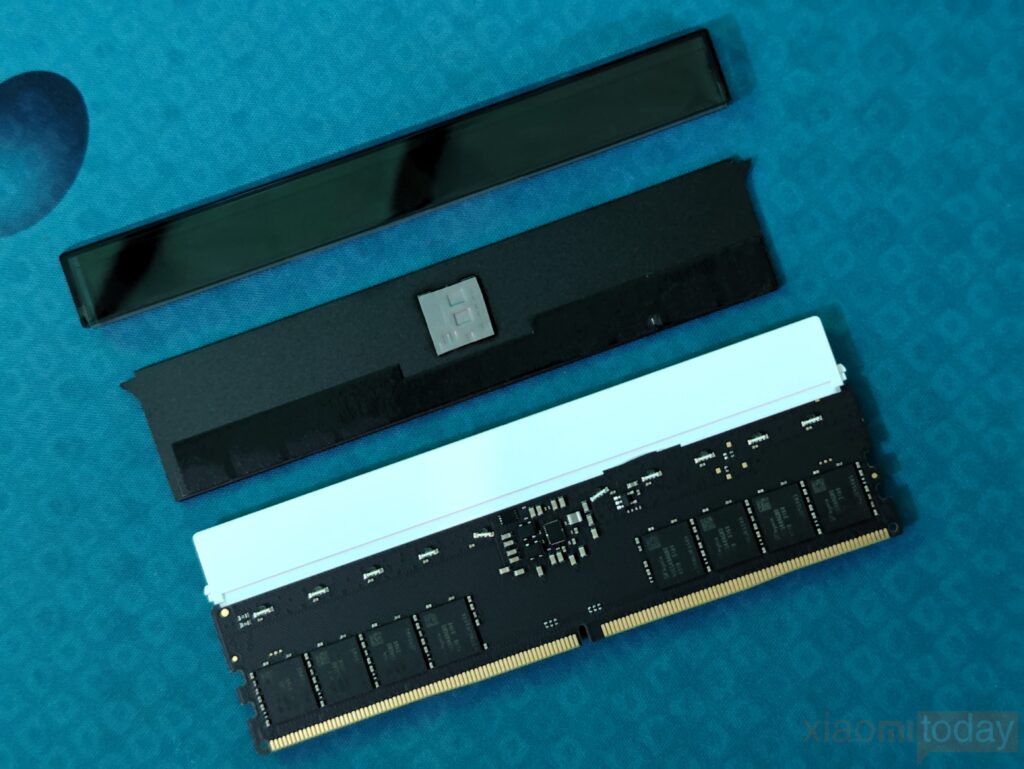
Once the heatsink is removed, the construction of the XTREEM ARGB D5 reveals its use of ten 10-layer, 2-ounce copper-plated circuit boards. This design supports efficient thermal conductivity, lowers electrical resistance, and ensures a stable, clear signal transmission. A layer of thermal paste between the heatsink and the memory chips further aids in heat dissipation, optimizing overall thermal performance.


Memory capacity is calculated using binary-based increments—typically 4GB, 8GB, and up to 16GB, with 1GB equating to 1024MB. This T-Force XTREEM ARGB D5 Kit consists of 8x 2GB chips (16GB total), utilizing non-binary SK Hynix H5CG48AGBD A-Die chips with a second-line serial code of X018. In a key shift from DDR4, where the power supply remains on the motherboard, DDR5 integrates it directly onto the DIMM PCB, enhancing signal integrity and reducing noise by minimizing power supply distance. The kit incorporates a RICHTEK RTQ5132 PMIC, converting the motherboard’s 5V input into the necessary VDD, VDDQ, and VPP power for efficient operation.
Performance Test
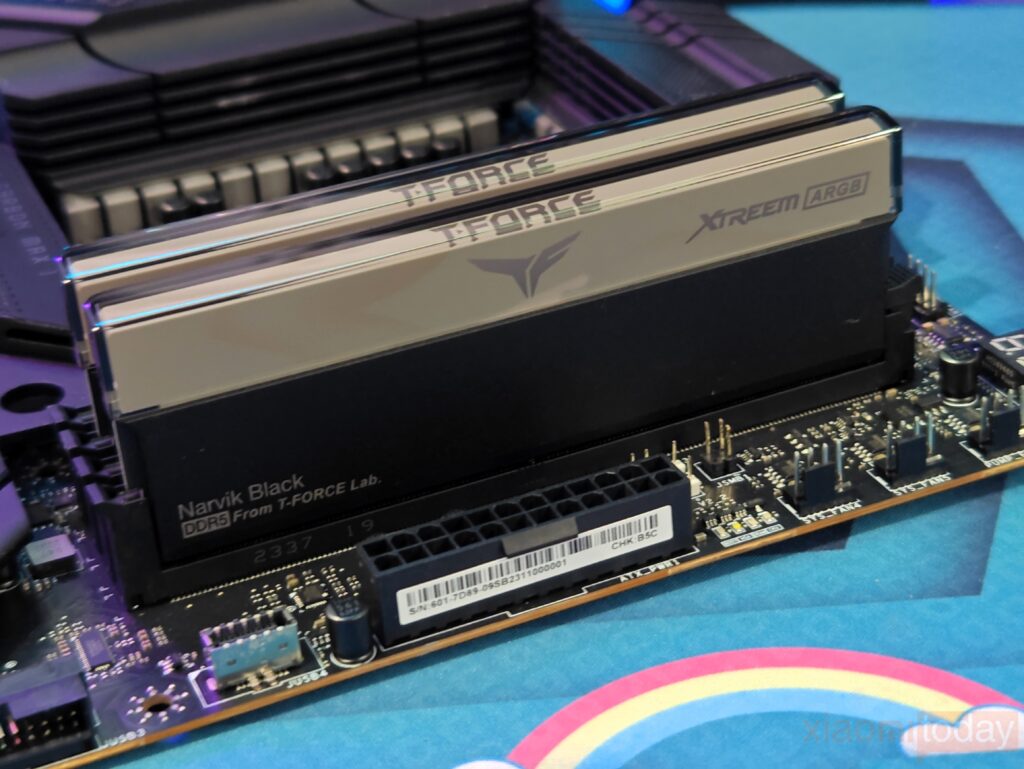
For this review, we used the MSI MPG Z790 CARBON MAX WIFI II motherboard alongside the Intel Core i7-13700K, which handled overclocking tasks smoothly. Tests were conducted using the default AUTO settings, XMP profiles, and additional manual overclocking to measure the memory’s capabilities under different conditions. Here’s an in-depth analysis of the T-Force XTREEM ARGB DDR5-6800MHz ARGB Memory’s performance across these configurations.

CPU-Z software was used to view detailed hardware information. This tool accurately displayed parameters for each system component, confirming the CPU and motherboard details. The high-frequency performance of memory is influenced by both motherboard and CPU compatibility. With advancements in motherboard technology, newer models generally support high-frequency DDR5 memory. Before installing, it’s advisable to review the motherboard’s specifications to ensure compatibility with the maximum supported memory frequency.
The Memory and SPD pages in CPU-Z offer detailed insights into the memory’s specifications. On the Memory page, we observe the default operating frequency set at 5600MHz, aligning with DDR5 memory standards across the board. Moving to the SPD page, we find four preset parameter profiles stored within the memory, enabling the motherboard to configure its operating frequency accordingly.

The first two profiles are set to 5600MHz, while the remaining reach up to 7600MHz, users can easily activate these higher-frequency profiles via BIOS, providing a straightforward way to boost memory performance and maximize their system’s potential.
After enabling the XMP profile, the memory operates at a frequency of 7600MHz, reflecting an adjustment in key parameters, including the timing of 36-45-45-84. These changes indicate that the memory maintains stable performance at this elevated frequency, aligning with the specifications for optimal functionality in high-performance systems.
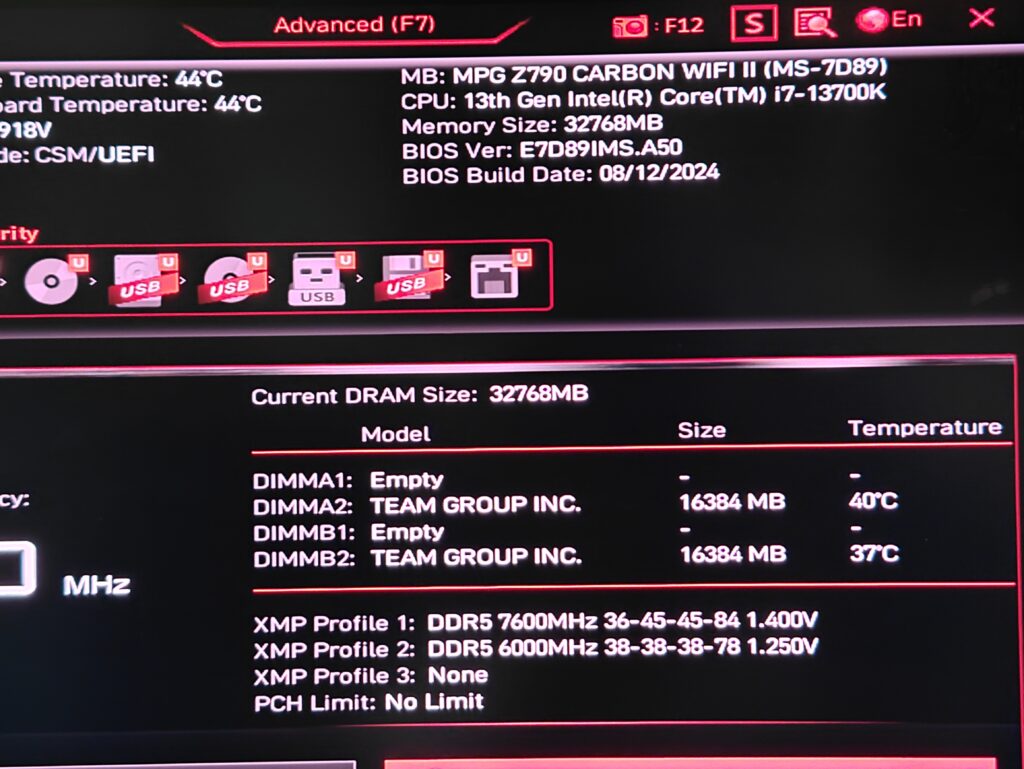
In the BIOS of the MSI MPG Z790 CARBON MAX WIFI II motherboard, this memory kit offers two built-in XMP profiles for tuning performance. Choosing XMP Profile 1 maximizes performance by setting the memory to DDR5-7600 with timings of CL 36-45-45-84 at 1.4V. For systems that encounter stability issues at this speed, XMP Profile 2 offers a balanced alternative, running the memory at DDR5-6000 with CL 38 timings, which may improve stability while still delivering strong performance.
Benchmarks

Testing with AIDA64 software at the default frequency of 5600MHz, the memory module delivered a read speed of 81,440 MB/s, a write speed of 75,626 MB/s, a copy speed of 93,649 MB/s, and a latency of 90.7 nanoseconds. These results demonstrate a strong performance at this frequency, with the read and write speeds highlighting the module’s capability to handle data-intensive tasks efficiently. The relatively low latency further supports responsiveness, essential for applications requiring rapid memory access.
When XMP mode is enabled, you can choose between two frequency options: 6000MHz and 7600MHz.
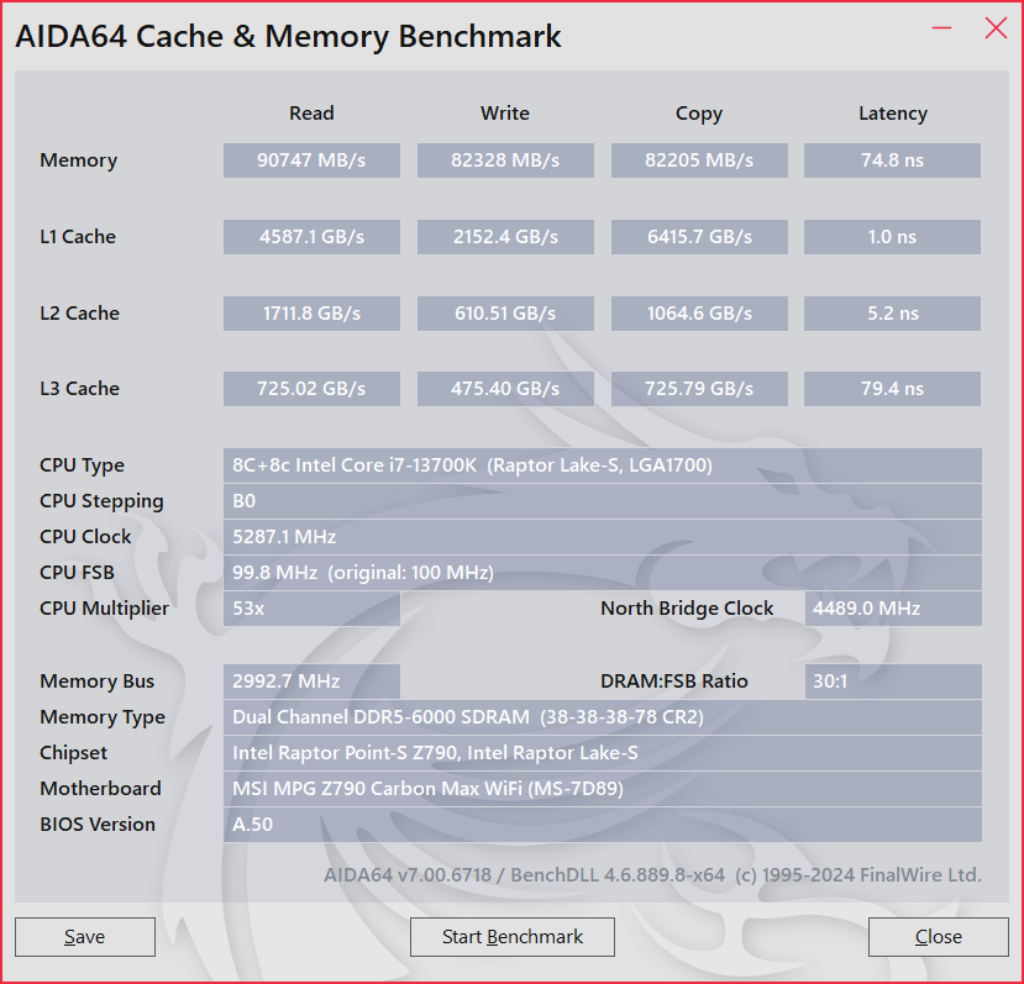
Testing the 6000 MHz (Profile 2) in XMP mode reveals a configuration with timings set to 38-38-38-78. Under this setup, the module achieves a reading speed of 90,747 MB/s and a writing speed of 82,328 MB/s. The copy speed measures 82,205 MB/s, while latency registers at 74.8 ns. These results reflect the module’s high throughput performance and efficiency in this profile.

With the manual overclock set to 6800 MHz and timings adjusted to 38-42-42-90, the memory demonstrated a marked boost in read and write speeds, reaching 97,865 MB/s and 88,434 MB/s, respectively, alongside a latency of 75.8ns. This configuration offers a reliable and high-performance option, particularly well-suited for gaming, delivering a seamless and responsive experience at this frequency.

When the XMP was adjusted to 7600MHz (Profile 1) for testing, the performance saw noticeable improvements. The reading speed increased to 108.29 GB/s, while the writing speed reached 109.52 GB/s, and the copying speed hit 97.079 MB/s. Additionally, latency was reduced to 70.0 ns. These results highlight a significant boost in overall performance when the memory operates at 7600 MHz, with enhanced speeds across all tested categories and lower latency. The system handled both software and gaming tasks effortlessly during testing.

The T-FORCE XTREEM ARGB DDR5 memory proves to be highly overclockable, with its manual settings pushing the frequency from 7600 MHz to 8000 MHz. This results in a noticeable increase in performance across various benchmarks. Read speeds reach 112.60 GB/s, while write speeds at 99.440 MB/s. Copy speeds also show an improvement, peaking at 103.04 GB/s. Additionally, latency is reduced to 68.6ns, highlighting the memory’s potential for high-performance tasks when overclocked.

In terms of temperature, during testing, we ran the AIDA64 Test on the memory at 7600MT/s. The maximum temperatures recorded for the two memory modules were 51.5℃ and 55.3℃, as seen through HWinfo. These results indicate that the memory maintains a solid temperature performance, ensuring stable operation throughout the test.




